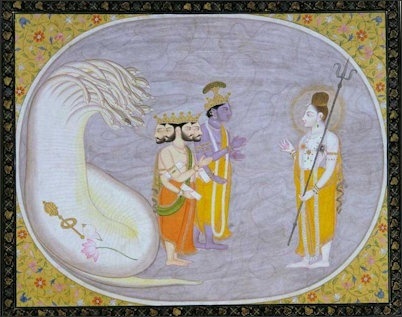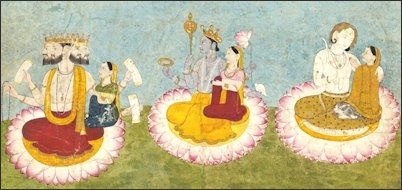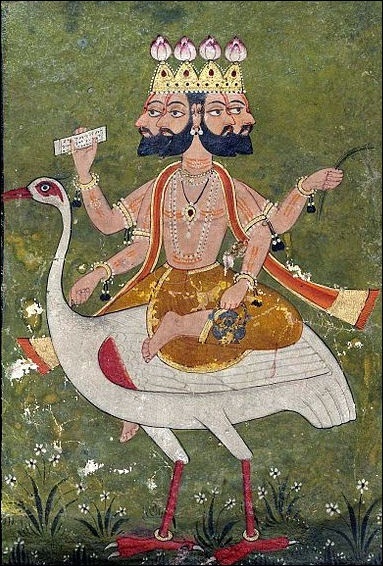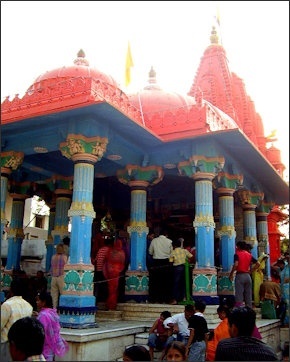BRAHMA, VISHNU, SHIVA

Brahma, Vishnu and Shiva revealed in the Cosmic Ocean
The Hindu triumvirate consists of three gods — Brahma, Vishnu and Shiva — who are responsible for the creation, upkeep and destruction of the world. Vishnu is the preserver of the universe, while Shiva's role is to destroy it in order to re-create. Brahma's job was creation of the world and all creatures. His name should not be confused with Brahman, who is the supreme God force present within all things. [Source: BBC]
Brahma is not worshipped and there are very few temples in his honor due to 'mythological' reasons. Vishnu (and the incarnations of Him, Rama and Krishna), Shiva (and his various forms), their wives, are very popular with numerous temples and followers. The wives of Brahma, Vishnu, and Shiva are Saraswati, Laxmi, and Parvati, respectively. Collectively, they are sometimes referred to as Divine mother (or Shakti). Two of Parvati's fierce but very powerful forms are Durga and Kali.
Vinay Lal, a professor of history at UCLA writes: “Shiva is represented as the Destroyer, Brahma as the Creator: Vishnu holds the universe in balance, acting as the Preserver. However, the worship of Brahma is almost unknown in India, and Indian sectarian history and conflict resolves itself largely, though by no means exclusively, into a struggle between the adherents of Shiva, called Saivites, and the followers of Vishnu or Vaishnavites. The rival claims of the followers of Shiva and Vishnu are found in most Indian texts, stretching as far back as the Mahabharata, but there are also attempts to reconcile these claims with the argument that Shiva and Vishnu are in reality one. Thus, according to the Harivamsa, there is "no difference between Shiva who exists in the form of Vishnu, and Vishnu who exists in the form of Shiva." [Source: Vinay Lal, professor of history, UCLA]
Steven M. Kossak and Edith W. Watts from The Metropolitan Museum of Art wrote: “Initially, Hinduism was centered around three male gods: Brahma, creator of the cosmos; Vishnu, preserver and protector of the universe; and Shiva, destroyer of the universe so that from the formless void it may be created again. Brahma has never had a large number of worshippers. Shiva, Vishnu, and the Great Goddess Devi (Mahadevi) in their myriad forms are the most widely worshipped Hindu gods. They are described in the Puranas, a group of texts formulated between A.D. 200 and 800.” [Source: Steven M. Kossak and Edith W. Watts, The Art of South, and Southeast Asia, The Metropolitan Museum of Art, New York]

Brahma, Vishnu and Shiva seated on lotuses with their consorts, Saraswati, Lakshmi and Paravati respectively, ca 1770, Guler, India
Brahma is the creator of the Universe and the god of wisdom. He is one of the three most important Hindu gods. Brahma is shown as a man with red skin wearing white robes and riding on a goose or a swan. He has four arms in which he carries the Vedas, and a combination of the following things: a sceptre, a spoon, a string of beads, a bow and a water jug. There are many different stories about Brahma's birth. One story is that Brahma hatched from a floating golden egg. Another story is that he was born from a lotus which grew out of Vishnu's navel. Brahma created his consort who is known by several names: Satarupa, Savitri, Sarasvati, Gayatri and Brahmani. [Source: British Museum]
Shiva is the god who destroys the world when it is in a state of chaos and ungodliness. He is also the lord of the beasts. Shiva is associated with meditation. Shiva wears a snake coiled round his neck and hair. He holds a trident in his hand and sits on a deer skin in a yogic position. Shiva rides on a bull called Nandi. Shiva's wife is Parvati and his son is Kartikeya.
Vishnu was a minor deity in early times. Later on, he became one of the main Hindu gods. He appears as a man with four arms riding on a mythical bird or resting on a serpent. In his four hands, Vishnu holds a conch shell, a discus, a lotus and a mace. From time to time, Vishnu descends to earth in a human, animal or creature form to restore the balance of good and evil in the world. It is thought that he has descended nine times already. Some of his more well-known incarnations are the hero Krishna, the hero Rama, a tortoise and a fish.
Websites and Resources on Hinduism: Hinduism Today hinduismtoday.com ; India Divine indiadivine.org ; Wikipedia article Wikipedia ; Oxford center of Hindu Studies ochs.org.uk ; Hindu Website hinduwebsite.com/hinduindex ; Hindu Gallery hindugallery.com ; Encyclopædia Britannica Online article britannica.com ; International Encyclopedia of Philosophy iep.utm.edu/hindu ; Vedic Hinduism SW Jamison and M Witzel, Harvard University people.fas.harvard.edu ; The Hindu Religion, Swami Vivekananda (1894), .wikisource.org ; Advaita Vedanta Hinduism by Sangeetha Menon, International Encyclopedia of Philosophy (one of the non-Theistic school of Hindu philosophy) iep.utm.edu/adv-veda ; Journal of Hindu Studies, Oxford University Press academic.oup.com/jhs
RECOMMENDED BOOKS:
“Hindu Myths: A Sourcebook” translated from the Sanskrit by Wendy Doniger (Penguin Classics, 2004) Amazon.com ;
“Indian Mythology” by Veronica Ions (Peter Bedrick 1984) Amazon.com ;
“Hindu Gods and Goddesses” by Swami Harshananda (Author), M.T.V. Acharya (Illustrator) Amazon.com ;
“Hindu Goddesses: Visions of the Divine Feminine in the Hindu Religious Tradition” (Studies in the History of Religions) by David Kinsley Amazon.com ;
“Myths and Symbols in Indian Art and Civilization” by Heinrich Zimmer (Princeton University Press, 1992) Amazon.com ;
"An Introduction to Hinduism" by Gavin Flood Amazon.com ;
"The Hindus: An Alternative History" by Wendy Doniger; Amazon.com ;
“The Mahabharata” by John D. Smith and Anonymous (Penguin Classics) Amazon.com ;
“The Bhagavad Gita” by Anonymous and Laurie L. Patton (Penguin Classics)
Amazon.com ;
“The Ramayana: A Shortened Modern Prose Version of the Indian Epic” by by R. K. Narayan and Pankaj Mishra (Penguin Classics) Amazon.com ;
“The Illustrated Ramayana: The Timeless Epic of Duty, Love, and Redemption”
by DK and Bibek Debroy Amazon.com
BRAHMA

Brahma on Hamsa
Brahma is the first god in the Hindu triumvirate, or trimurti Brahma is the "father of all" and has traditionally been recognized as the creator god. He is rarely depicted and is not worshiped as other gods in part because he has already fulfilled his duty by creating everything and will not do anything until the beginning of the next creation cycle.Brahma is also known Ishwara or Mahanshakti. His shakti or consort is Saraswati, the goddess of knowledge, music and poetry. She is often depicted holding a musical instrument in her hand. The swan (or goose), a symbol of knowledge, is the mount for both Brahma and Saraswati. Brahma is also sometimes recognized as the “Self,” and is represented by “Om,” the sound with no form. Brahma should not be confused with Brahman, who is the supreme God force present within all things.
Brahma is a representation of the impersonal brahman in a human form, usually with four faces facing the cardinal directions and four arms. In reality, Brahma receives little devotion from worshipers, who may mention him in passing while giving their attention to the other main gods. There are few temples in India dedicated to him; instead, his image may stand in niches on the walls of temples built for other deities. Religious stories usually place Brahma as an intermediate authority who cannot handle a problem and passes it on to either Vishnu or Shiva. The concept of the trinity (trimurti ), expressed in beautiful art works or invoked even by believers, is in practice a philosophical construct that unites all deistic traditions within Hinduism into one overarching symbol. [Source: Library of Congress *]
When Brahma is depicted he is show with four, crowned, bearded heads — each facing towards one of the cardinal points — and has eight arms, in which he carries: 1) the four Vedas, 2) a rosary, 3) a pot with holy water, 4) a scepter, 5) a spoon, 6) a disc, 7) a fly whisk, and 8) a lotus flower. It is believed that his heads came from the four Vedas (the most ancient religious texts for Hindus).
Brahma is said to have been born from a golden egg or a lotus flower that sprung from the naval of Vishnu, while he reclined on a serpent on the waves of the ocean during a cosmic sleep. Brahma originally had five heads. He acquired them when he fell in love with Saraswati — who was shy and tried to escape his glances — so he could see wherever she went. Some also believe that the caste system, or four varnas, came from different part of Brahma's body.
Brahman and God
All Hindu gods are regarded as refracted image of Brahma. He created the universe and founded a tradition of teachers. He taught everything he knew to the great sage Narada Muni, who taught it to Vyasadeva, the compiler of the “Bhagavad Gita”.
Vedanta, the basis of Hinduism, asserts that Brahman,the 'impersonal' God and the universal soul, is the Absolute Truth. Brahman has multiple roles to play: the creator, the maintainer, and the destroyer all in one. This can be viewed as the origin of the trinity Gods namely Brahma, Vishnu, and Shiva.
Gavin Flood wrote: “Brahman is a Sanskrit word which refers to a transcendent power beyond the universe. As such, it is sometimes translated as 'God' although the two concepts are not identical. Brahman is the power which upholds and supports everything. According to some Hindus this power is identified with the self (atman) while others regard it as distinct from the self. Most Hindus agree that Brahman pervades everything although they do not worship Brahman. Some Hindus regard a particular deity or deities as manifestations of Brahman.” [Source: Prof. Gavin Flood, BBC]
Why Is Brahma Not Worshipped So Much?

Brahma Temple in Pushkar
Brahma is the least worshipped major god in Hinduism today. It is said there is only one Brahma temple in all of India, in the town of Pushkar in Rajasthan, compared with the many thousands devoted to Shiva and Vishnu. This is not completely true. There are other Brahma temple but it safe to say there are not many of them. A number of stories in the Hindu mythology attempt to explain why he is rarely worshipped. According to one view Brahma's role as the creator is over and thsu why is it necessary to worship him. Because Vishnu preserves the world and Shiva keeps the cycle of death and rebirth going it makes more sense to worship them. [Source: BBC |::|]
“One story that explains why Brahma is not worshiped, according to the BBC, goes: Brahma created a woman in order to aid him with his job of creation. She was called Shatarupa. She was so beautiful that Brahma became infatuated with her, and gazed at her wherever she went. This caused her extreme embarrassment and Shatarupa tried to turn from his gaze. But in every direction she moved, Brahma sprouted a head until he had developed four. Finally, Shatarupa grew so frustrated that she jumped to try to avoid his gaze. Brahma, in his obsession, sprouted a fifth head on top of all. |::|
“It is also said in some sources that Shatarupa kept changing her form. She became every creature on earth to avoid Brahma. He however, changed his form to the male version of whatever she was and thus every animal community in the world was created. Lord Shiva admonished Brahma for demonstrating behaviour of an incestuous nature and chopped off his fifth head for 'unholy' behaviour. Since Brahma had distracted his mind from the soul and towards the cravings of the flesh, Shiva's curse was that people should not worship Brahma. As a form of repentance, it is said that Brahma has been continually reciting the four Vedas since this time, one from each of his four heads. |::|
VISHNU
Vishnu is known as the Preserver and is a god with many incarnations. Generally regarded as nice, eternally young and attractive, he is often depicted with a crown and reclining on a multi-headed serpent with a lotus flower emerging from his navel. He usually has four arms. One carries a mace, which represents the basic force from which all other forces are derived. The others hold a conch, a disc, and a ball or a lotus. Lakshmi, the Goddess of Wealth is Vishnu's wife. Their mount in Garuda, the man-eagle.

Vishnu, Raja Ravi, Varma and Lord_GarudaSteven M. Kossak and Edith W. Watts from The Metropolitan Museum of Art wrote: “Vishnu preserves and maintains order in the universe. Whenever destructive forces, usually symbolized by demons, threaten to overwhelm the world, Vishnu descends in the form of an avatar to restore moral order. His concern for human political and social activities expresses the gentle and just-minded side of the One. It is believed that in our present universe, Vishnu has already appeared in nine incarnations, taking such animal forms as a fish and a tortoise and various human forms such as Krishna, Rama, and the Buddha. It is believed he will appear once more in the future. As Rama, he symbolizes the importance of loyalty and obedience. As Krishna, he is the divine lover as well as a slayer of demons. Krishna’s consort, Radha, and his female devotees, in their passionate longing for him, symbolize the soul’s desire to be one with God.” [Source: Steven M. Kossak and Edith W. Watts, The Art of South, and Southeast Asia, The Metropolitan Museum of Art, New York]
The historical Vishnu is good example of a single god that was coalesced from multiple gods over time. In the early Vedic verses Vishnu was a dwarf capable of crossing the universe in three strides. He was a minor deity who performed these feats mainly to amuse the other gods and was mentioned only five times in the Rig Veda. His antics as a dwarf made him popular and he became a major god, it is believed, after he was merged with an early sun god.
Vishnu is associated with “right action” and is considered an upholder of Hindu values. He preserves the universe by staying awake. If he falls asleep creation will withdraw intro a seed from it which it will emerge when creation occurs again. His role as preservers is greatly valued by Indians who worship Vishnu and pay homage to him in many ways. Vaishnavites, devotees of Vishnu, are one of the largest Hindu sects. See Sects.
See Separate Article: VISHNU: HIS AVATARS, IMAGES, STORIES AND RELATIONS WITH OTHER GODS factsanddetails.com
SHIVA

Bearded Shiva Shiva (Siva) is regarded as the destroyer, preserver, and creator because he completes the Hindu cosmological cycle and ushers in the return of creation. He wears a chignon with curls and has a vertical third eye in the middle of his forehead. He often is depicted with four arms, carrying a string of beads, a symbol of his teaching, and a trident. The beads are called Rudraksha beads, a reference to his early name. Hindus who worship Shiva as their primary god are members of the Shaivism sect.
Steven M. Kossak and Edith W. Watts from The Metropolitan Museum of Art wrote: “Shiva is worshipped as the ascetic god, remote when in meditation but also at times wild, passionate, and loving. As Lord of the Dance, he both destroys and creates the universe. His cosmic dance visualizes the cycles of creation and destruction in human lives, in the history of nations, and in the universe. Shiva is also manifest in a phallic emblem called a linga, and it is in this form that he is most often portrayed in the inner sanctum of his temples. Worshippers of Shiva believe that he is the supreme god who contains and controls all creation.” [Source: Steven M. Kossak and Edith W. Watts, The Art of South, and Southeast Asia, The Metropolitan Museum of Art, New York]
In the Vedic verses Shiva was known as Rudra, a minor deity that protected cattle and was associated with the howl of the wind and healing herbs. He had both and positive and negative side: he could bring disease and he could cure it. In the Rig Veda he is mentioned only three times. Over time Rudra absorbed merged with an early fertility god and became Shiva. By the second century B.C. Shiva had become popular as indicated by the large number stone lingams, symbols of Shiva, found in archeological sites. In the A.D. 2nd century there were Shiva cults made up of devotees who made lewd gestures at women and sneering noises during ceremonies and slept in the ashes left behind from funeral pyres. By the seventh century Shiva had became a more mainstream Hindu God.
Shiva lives in his paradise on Mt. Meru (believed by many to be Mt. Kailas in Tibet), ), where he created the Ganges. He is the originator of all the performing arts. The rhythm of his drum and his dancing are thought to control the fate of the world and prepare it for a new creation. Shiva has many incarnations and appears in many different forms. They are sometimes better known and depicted more than Shiva himself. In the "Shiva Purana", a medieval text devoted to Shiva, he has over 1,000 names, including Mahakala, the Lord of Time, and Maheshvara, the Lord of Knowledge.
See Separate Article: SHIVA: IMAGES, DESTRUCTION, SYMBOLS AND OTHER GODS factsanddetails.com
Image Sources: Wikimedia Commons
Text Sources: “World Religions” edited by Geoffrey Parrinder (Facts on File Publications, New York); “Encyclopedia of the World’s Religions” edited by R.C. Zaehner (Barnes & Noble Books, 1959); “Encyclopedia of the World Cultures: Volume 3 South Asia “ edited by David Levinson (G.K. Hall & Company, New York, 1994); “The Creators” by Daniel Boorstin; “A Guide to Angkor: an Introduction to the Temples” by Dawn Rooney (Asia Book) for Information on temples and architecture. National Geographic, the New York Times, Washington Post, Los Angeles Times, Smithsonian magazine, Times of London, The New Yorker, Time, Newsweek, Reuters, AP, AFP, Lonely Planet Guides, Compton’s Encyclopedia and various books and other publications.
Last updated December 2023
